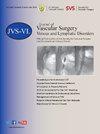Efficacy and safety of ovarian vein embolization with N-butyl-2 cyanoacrylate for pelvic venous disorder: Analysis of 100 cases
IF 2.8
2区 医学
Q2 PERIPHERAL VASCULAR DISEASE
Journal of vascular surgery. Venous and lymphatic disorders
Pub Date : 2025-05-06
DOI:10.1016/j.jvsv.2025.102256
引用次数: 0
Abstract
Objective
The aim of this study was to evaluate the safety and efficacy of ovarian vein embolization using N-butyl-2 cyanoacrylate (NBCA) for treating pelvic venous disorder-associated chronic pelvic pain.
Methods
This retrospective study analyzed 100 patients who underwent ovarian vein embolization with NBCA at a single institution between February 2018 and June 2024. Pelvic venous insufficiency was confirmed by duplex ultrasound and abdominal computed tomography or magnetic resonance imaging, and NBCA was the sole embolic agent. Pain levels were assessed pre- and post-procedure using the Visual Analogue Scale (VAS) in three categories: pain on standing, dyspareunia, and menstrual pain. Follow-up included clinical evaluation and VAS scoring at 1 to 3 months and annually. Statistical analysis determined the significance of pain reduction.
Results
Technical success was achieved in all cases, with complete occlusion of the target veins. Clinical success was observed in most patients, with significant improvement in VAS scores across all categories (P < .05). Due to symptom recurrence, four patients (4%) required reintervention during follow-up. No NBCA-related complications were reported.
Conclusions
In our study, ovarian vein embolization with NBCA appears to be a safe and effective treatment for pelvic venous disorder-associated chronic pelvic pain, providing significant pain relief. Additionally, it offers advantages over permanent metal implants such as the potential for gradual polymer degradation over time and avoiding interference in future imaging studies.
卵巢静脉栓塞治疗盆腔静脉疾病100例疗效及安全性分析。
目的:评价n -丁基-2氰基丙烯酸酯(NBCA)卵巢静脉栓塞治疗盆腔静脉疾病(PeVD)相关慢性盆腔疼痛(CPP)的安全性和有效性。方法:本回顾性研究分析了2018年2月至2024年6月在同一家机构接受NBCA卵巢静脉栓塞治疗的100例患者。盆腔静脉功能不全经双超声及腹部CT或MRI证实,NBCA为唯一栓塞剂。采用视觉模拟量表(VAS)对手术前后的疼痛水平进行评估,分为站立疼痛、性交困难和月经疼痛三类。随访包括1-3个月和每年的临床评估和VAS评分。统计学分析确定疼痛减轻的意义。结果:所有病例均取得技术成功,靶静脉完全闭塞。大多数患者临床成功,VAS评分各类别均有显著改善(p < 0.05)。随访期间因症状复发,4例(4%)患者需要再次干预。未见nba相关并发症的报道。结论:在我们的研究中,卵巢静脉栓塞NBCA似乎是一种安全有效的治疗pevd相关CPP的方法,可以显著缓解疼痛。此外,与永久性金属植入物相比,它具有一些优势,例如随着时间的推移,聚合物可能会逐渐降解,并且避免对未来成像研究的干扰。
本文章由计算机程序翻译,如有差异,请以英文原文为准。
求助全文
约1分钟内获得全文
求助全文
来源期刊

Journal of vascular surgery. Venous and lymphatic disorders
SURGERYPERIPHERAL VASCULAR DISEASE&n-PERIPHERAL VASCULAR DISEASE
CiteScore
6.30
自引率
18.80%
发文量
328
审稿时长
71 days
期刊介绍:
Journal of Vascular Surgery: Venous and Lymphatic Disorders is one of a series of specialist journals launched by the Journal of Vascular Surgery. It aims to be the premier international Journal of medical, endovascular and surgical management of venous and lymphatic disorders. It publishes high quality clinical, research, case reports, techniques, and practice manuscripts related to all aspects of venous and lymphatic disorders, including malformations and wound care, with an emphasis on the practicing clinician. The journal seeks to provide novel and timely information to vascular surgeons, interventionalists, phlebologists, wound care specialists, and allied health professionals who treat patients presenting with vascular and lymphatic disorders. As the official publication of The Society for Vascular Surgery and the American Venous Forum, the Journal will publish, after peer review, selected papers presented at the annual meeting of these organizations and affiliated vascular societies, as well as original articles from members and non-members.
 求助内容:
求助内容: 应助结果提醒方式:
应助结果提醒方式:


